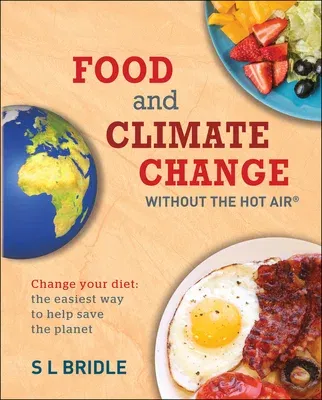A quarter of the greenhouse-gas emissions that cause climate change come
from food. In Food and Climate Change without the hot air, Sarah
Bridle details the carbon footprint of the food we eat, from breakfast
to lunch, from snacks to supper. She breaks down the environmental
impact of each food, so we can see where the emissions are highest and
where we can make sustainable food choices.
With this knowledge, we can make changes to our diet - e.g. eating more
locally grown produce and introducing meat free days. This will reduce
the greenhouse gas emissions so damaging to our planet and probably be
healthier for us, too.
Food and Climate Change without the hot air considers:
- How to reduce the greenhouse gas emissions that come from food -
currently 25%.
- What effect the food we eat has on the environment of our planet.
- How climate change will affect the food we will eat in the future.
- How consumers can play their part in reducing food-based carbon
emissions.
Bridle looks at popular breakfast, lunch, snack and dinner options, such
as tea and coffee, eggs, cheese and chicken sandwiches, salad, pizza,
baked potatoes, chocolate, nuts, soft drinks, alcoholic beverages, steak
and fries, fish suppers, Spaghetti Bolognese and more.
She calculates the greenhouse gas emissions of those meals, breaking
down the different ingredients and cooking methods, which makes it easy
to compare different options within the same meal. This takes into
account all the gases that contribute to global warming: carbon dioxide,
methane and nitrous oxide (gCO2e). Bridle also dives into the important
topic of food waste and gives valuable tips to avoid leftovers.
Inspired by the author's former mentor David MacKay (Sustainable Energy
without the hot air), Food and Climate Change is a rigorously
researched discussion of how food and climate change are intimately
connected. In this ground-breaking and accessible work, Prof Sarah
Bridle focuses on the facts so that they speak for themselves. The book
is highly illustrated in full color throughout, making it an attractive
read, as well as an inspiring one.
It shows how anyone can reduce the climate impact of their food. It also
suggests how the food system must change, with:
- Incentives for farmers to switch to more efficient, climate-friendly
technologies.
- Food labeling to show a product's 'food miles' and how it has been
produced.
- Research into non-traditional production methods.
- How to waste less food and use all the water, energy and nutrients
used in its production more wisely and sustainably.

